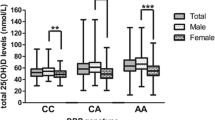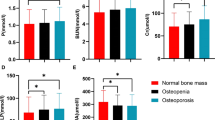Abstract
The purpose of this study was to examine the relationships between peak bone mass and genetic and environmental factors. We measured whole-body bone mineral density (BMD), lumbar spine BMD, and radius BMD with dual-energy X-ray absorptiometry (DXA) and analyzed eight genetic factors: vitamin D receptor (VDR)-3′, VDR-5′, estrogen receptor (ER), calcitonin receptor (CTR), parathyroid hormone (PTH), osteocalcin (OC), apolipoprotein E (ApoE), and fatty acid binding protein 2 (FABP2) allelic polymorphisms using polymerase chain reaction-restriction fragment length polymorphisms (PCR-RFLPs). We also surveyed menstrual history, food intake, and history of physical activity using questionnaires.
After adjusting for age, body mass index (BMI), current smoking status, current Ca intake, alcohol intake, menoxenia, and physical activity, the mean BMD in subjects with the HH/Hh genotype was significantly higher than that of subjects with the hh genotype for whole-body BMD (mean±SD, 1.20±0.10 vs. 1.18±0.09 g/cm2; HH/Hh vs. hh, p=0.04) and at lumbar spine BMD (mean±SD, 1.18±0.14 vs. 1.14±0.12 g/cm2; HH/Hh vs. hh, p=0.02) in OC allelic polymorphism. Furthermore, the results of multiple regression analyses taking the 8 genetic factors plus the 7 environmental factors listed above into account showed that the strongest factor contributing to BMD was BMI at any site (whole-body and lumbar BMD p<0.0001, radius BMD p=0.0029). In addition, OC polymorphism (p=0.0099), physical activity (p=0.0245), menoxenia (p=0.0384), and PTH polymorphism (p=0.0425) were independent determinants for whole-body BMD, and OC polymorphism (p=0.0137) and physical activity (p=0.0421) were independent determinants for lumbar BMD and radius BMD, respectively.
Similar content being viewed by others
References
Riggs BL, Melton III LJ. Involutional osteoporosis. N. Engl. J. Med., 1986; 314: 1676–1686.
Yamagata Z, Miyamura T, Iijima S, Asaka A, Sasaki M, Kato J, Koizumi K. Vitamin D receptor gene polymorphism and bone mineral density in healthy Japanese women. Lancet 1994; 344: 1027.
Gross C, Eccleshall TR, Malloy PJ, Villa ML, Marcus R, Feldman D. The presence of a polymorphism at the translation initiation site of the vitamin D receptor gene is associated with low bone mineral density in postmenopausal Mexican-American women. J. Bone Miner. Res., 1996; 11: 1850–1855.
Kobayashi S, Inoue S, Hosoi T, Ouchi Y, Shiraki M, Orimo H. Association of bone mineral density with polymorphism of the estrogen receptor gene. J. Bone Miner. Res., 1996; 11: 306–311.
Masi L, Becherini L, Gennari L, Colli E, Mansani R, Falchetti A, Cepollaro C, Gonnelli S, Tanini A, Brandi ML. Allelic variants of human calcitonin receptor: distribution and association with bone mass in postmenopausal Italian women. Biochem. Biophys. Res. Commun. 1998; 245: 622–626.
Hosoi T, Miyao M, Inoue S, Hoshino S, Shiraki M, Orimo H, Ouchi Y. Association study of parathyroid hormone gene polymorphism and bone mineral density in Japanese postmenopausal women. Calcif. Tissue Int. 1999; 64: 205–208.
Dohi Y, Iki M, Ohgushi H, Gojo S, Tabata S, Kajita E, Nishino H Yonemasu K. A novel polymorphism in the promoter region for the human osteocalcin gene: The possibility of a correlation with bone mineral density in postmenopausal Japanese women. J. Bone Miner. Res. 1998; 13: 1633–1639.
Shiraki M, Shiraki Y, Aoki C, Hosoi T, Ineue S, Kaneki M, Ouchi Y. Association of Bone Mineral Density with Apolipoprotein E Phenotype. J. Bone Miner Res. 1997; 12: 1438–1445.
Miyao M, Hosoi T, Inoue S, Hoshino S, Shiraki M, Orimo H, Ouchi Y. Polymorphism of insulin-like growth factor I gene and bone mineral density. Calcif. Tissue. Int. 1998; 63: 306–311.
Yamada Y, Hosoi T, Makimoto F, Tanaka H, Seino Y, Ikeda K. Transforming growth factor beta-1 gene polymorphism and bone mineral density in Japanese adolescents. Am. J. Med. 1999; 106: 477–479.
Keen RW, Woodford Richens KL, Grant SF, Ralston SH, Lanchbury JS, Spector TD. Association of polymorphism at the type I collagen (COL1A1) Iocus with reduced bone mineral density, increased fracture risk, and increased collagen turnover. Arthritis Rheum. 1999; 42: 285–290.
Murray RE, McGuigan F, Grant SF, Reid DM, Ralston SH. Polymorphisms of the interleukin-6 gene are associated with bone mineral density. Bone 1997; 21: 89–92.
Tsuji S, Munkhbat B, Hagihara M, Tsuritani I, Abe H, Tsuji K. HLA-A*24-B*07-DRB1*01 haplotype implicated with genetic disposition of peak bone mass in healthy young Japanese women. Hum. Immunol. 1998; 59: 243–249.
Ogawa S, Urano T, Hosoi T, Miyao M, Hoshino S, Fujita M, Shiraki M, Orimo H, Ouchi Y, Inoue S. Association of bone mineral density with a polymorphism of the peroxisome proliferator-activated receptor γ gene: PPAR γ expression in osteoblasts. Biochem. Biophys. Res. Cummun. 1999; 260: 127–130.
Morrison NA, Qi JC, Tokita A, Kelly PJ, Crofts L, Nguyen TV, Sambrook PN, Eisman JA. Prediction of vitamin D receptor alleles. Nature 1994; 367: 284–287.
Yaich L, Dupont WD, Cavener DR, Parl FF. Analysis of thePvull restriction fragment-length polymorphism and exon structure of the estrogen receptor gene in breast cancer and peripheral blood. Cancer Res. 1992; 52: 77–83.
Nakamura M, Zhang ZQ, Shan L, Hisa T, Sasaki M, Tsukino R. Yokoi T, Kaname A, Kakudo K. Allelic variants of human calcitonin receptor in the Japanese population. Hum. Genet. 1997; 99: 38–41.
Tsukamoto K, Watanabe T, Matsushima T, Kinoshita M, Kato H, Hashimoto Y, Kurokawa K, Teramoto T. Determination by PCR-RFLP of apo E genotype in a Japanese population. J. Lab. Clin. Med. 1993; 121: 598–602.
Baier LJ, Sacchettini JC, Knowler WC, Eads J, Paolisso G, Tataranni PA, Mochizuki H, Bennett PH, Bogardus C, Prochazka M. An amino acid substitution in the human intestinal fatty acid binding protein is associated with increased fatty acid binding, increased fat oxidation, and insulin resistance. J. Clin. Invest. 1995; 95: 1281–1287.
Fujita Y, Katsumata K, Unno A, Tokita A. Factors affecting peak bone density in Japanese women. Calcif. Tissue Int. 1999; 64: 107–111.
Health and Welfare Statistics Association eds. Journal of Health and Welfare Statistics, vol 46 (9): Tokyo; Health and Welfare Statistics Association, 1996.
Arai H, Miyamoto K, Taketani Y, Yamamoto H, Iemori Y, Morita K, Tonai T, Nishisho T, Mori S, Takeda E. A vitamin D receptor gene polymorphism in the translation initiation codon: effect on protein activity and relation to bone mineral density in Japanese women. J. Bone Miner. Res. 1997; 12: 915–921.
Lian JB, Friedman PA. The vitamin K-dependent synthesis of γ-carboxyglutamic acid by bone microsomes. J. Biol. Chem. 1978; 253: 6623–6626.
Pocock NA, Eisman JA, Hopper JL, Yeates MG, Sambrook PN, Eberl S. Genetic determinants of bone mass in adults. J. Clin. Invest 1987; 80: 706–710.
Hara S, Yanagi H, Amagai H, Endoh K, Tsuchiya S, Tomura S. The effect of physical activity during the teenage years, based on type of sports and duration of exercise, on bone mineral density of young, premenopausal Japanese women. Calcif. Tissiue Int. 2001; 68: 23–30.
Nishimoto SK and Price PA. Secretion of the vitamin K-dependent protein of bone by rat osteosarcoma cells. J. Biol. Chem. 1980; 255: 6579–6583.
Gross C, Krishnan AV, Malloy PJ, Eccleshall TR, Zhao X, Feldman D. The vitamin D receptor gene start codon polymorphism: A functional analysis ofFokI Variants. J. Bone Miner. Res. 1998; 13: 1691–1699.
Yanagi H, Tomura S, Kawanami K, Hosokawa M, Tanaka M, Kobayashi K, Tsuchiya S, Amagai H, Hayashi K, Hamaguchi H. Vitamin D receptor gene polymorphisms are associated with osteoporosis in Japanese women. J. Clin. Endocrinol. Metab. 1996; 81: 4179–4181.
Author information
Authors and Affiliations
Corresponding author
Rights and permissions
About this article
Cite this article
Hayakawa, Y., Yanagi, H., Hara, S. et al. Genetic and environmental factors affecting peak bone mass in premenopausal Japanese women. Environ Health Prev Med 6, 177–183 (2001). https://doi.org/10.1007/BF02897967
Received:
Accepted:
Issue Date:
DOI: https://doi.org/10.1007/BF02897967




